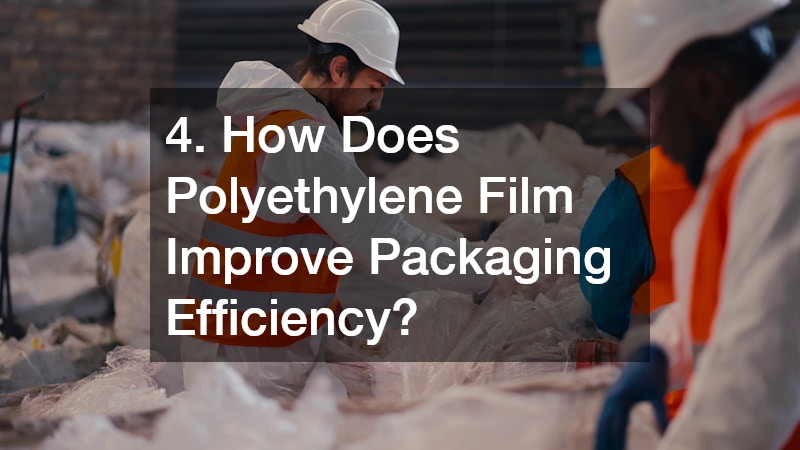Polyethylene film encompasses a versatile plastic material that permeates numerous industries with its invaluable applications. Understanding its varied uses can provide insight into its importance, such as in packaging, construction, and agriculture, which underscores its prevalence.
1. What is Polyethylene Film?
Polyethylene film is a flexible plastic sheet derived from polyethylene resin and is widely utilized due to its durability and versatility. Its significance lies in safeguarding products and minimizing wastage through efficient packaging solutions.
1.1 Types of Polyethylene Film
Low-density polyethylene (LDPE) film is favored for applications that require flexibility, including plastic bags and wraps. High-density polyethylene (HDPE), known for its strength and puncture resistance, is often employed in more demanding scenarios like construction sheeting.
Linear low-density polyethylene (LLDPE) offers a unique balance of strength and flexibility, making it perfect for stretch-wrap films and agricultural coverings. Each type of polyethylene film serves specific needs depending on environmental conditions and product requirements.
The diversity in polyethylene film extends to specialized forms, such as ultra-high molecular weight polyethylene (UHMWPE), which is engineered to provide exceptional durability. These options cater to diverse industry demands, enhancing product safety and longevity.
1.2 Manufacturing Process
The manufacturing process of polyethylene film starts by producing polyethylene resin, which is then melted and extruded into thin sheets. This extrusion is followed by cooling and winding, resulting in rolls that can be converted into specific products.
This process includes several methods, such as blown film extrusion and cast film extrusion, each serving unique applications and industrial requirements. Blown film extrusion, for instance, is commonly used for producing plastic bags and stretch films.
Further finishing processes like printing and laminating are often employed to customize the film for specific purposes or branding. These enhancements allow for greater functionality, such as improved barrier properties or aesthetic appeal.
2. What are the Uses of Polyethylene Film?
Polyethylene film is integral to industrial packaging, providing moisture barriers and protective layers for products during transportation. Its role in agriculture includes greenhouse covers and silage wraps, where it helps maintain crop yields and quality.
2.1 Industrial Applications
In construction, polyethylene film acts as a vapor barrier and protective sheeting to enhance insulation and protect structures from moisture and dust. The film’s durability and resistant properties make it a crucial component in these high-demand industrial environments.
Packaging industries benefit from polyethylene film for its lightweight and cost-effective properties, making it ideal for transporting and storing goods without adding significant weight. This efficiency translates into cost savings and reduced environmental impact.
The agriculture sector uses polyethylene film extensively in mulch films and greenhouse coverings to boost plant growth and rainfall efficiency. By managing temperature and light levels, polyethylene film helps increase agricultural productivity.
2.2 Everyday Uses
Polyethylene film is commonly found in household products like food packaging, where it extends shelf life by protecting against contaminants. The convenience and affordability of polyethylene wraps also make them a popular choice for everyday storage needs.
In consumer products, polyethylene film is used as liners for trash bags and protective coverings, illustrating its diverse applications in daily life. These features highlight the film’s ability to offer practical solutions for preservation and cleanliness.
Moreover, innovations are tapping into polyethylene film’s capabilities for enhanced food safety applications, such as antimicrobial coatings, further broadening its role in everyday use. Such developments continue to push the boundaries of polyethylene’s utility in domestic settings.
3. Why is Polyethylene Film Important for the Environment?
The ecological footprint of polyethylene film is a crucial concern, given its widespread usage and challenges in waste management. Recognizing limitations in biodegradability has sparked efforts towards enhancing recycling practices and developing sustainable solutions.
3.1 Biodegradability and Recycling
One of the challenges is that traditional polyethylene film is not biodegradable, which contributes to long-lasting environmental pollution when improperly disposed of. To mitigate this, many initiatives focus on improving recycling techniques to reduce landfill accumulation.
The development of advanced sorting and recycling facilities aims to support the reusability of polyethylene film as a resource rather than waste. Enhanced chemical recycling processes allow for the breakdown of polyethylene into its original compounds, enabling repeated cycles of use.
Companies are increasingly investing in closed-loop systems where polyethylene waste is reprocessed to create new products, thus minimizing ecological impact. By fostering circular economies, industries can reduce reliance on virgin materials and lessen ecological footprints.
3.2 Sustainable Alternatives
To address environmental concerns, research into biodegradable and compostable alternatives to polyethylene film is ongoing. These alternatives promise reduced environmental impact by enabling composting under industrial conditions.
Bioplastics, often derived from renewable resources like cornstarch or PLA (polylactic acid), strive to replicate polyethylene’s desirable properties with enhanced environmental performance. The growing emphasis on sustainability has accelerated their adoption in various sectors.
While these alternatives are promising, they also face challenges such as higher production costs and limitations in their current performance capabilities. Continued research is essential to overcome these barriers and facilitate widespread application.
4. How Does Polyethylene Film Improve Packaging Efficiency?
Polyethylene film plays a vital role in elevating packaging efficiency by ensuring that goods are adequately preserved and protected. This protective measure not only enhances product longevity but also reduces waste and resource usage.
4.1 Preservation and Protection
The film creates a barrier against moisture, dust, and other environmental contaminants, extending product shelf life considerably. These attributes are crucial for food items, electronics, and other perishables requiring robust protective measures.
In transportation, polyethylene film protects goods from mechanical damage, with added cushioning qualities further ensuring safety during handling. Such features reduce the risk of product loss or damage, promoting customer satisfaction and reducing costs.
4.2 Cost Effectiveness
Polyethylene film is renowned for its cost efficiency in production and application, contributing to the affordability of packaging solutions. Its lightweight nature also translates into lower shipping costs and reduced carbon emissions.
The film’s adaptability to different forms and functions allows businesses to tailor their packaging needs without incurring high expenses. Such versatility enables enterprises to maximize resource utilization and operational efficiency.

